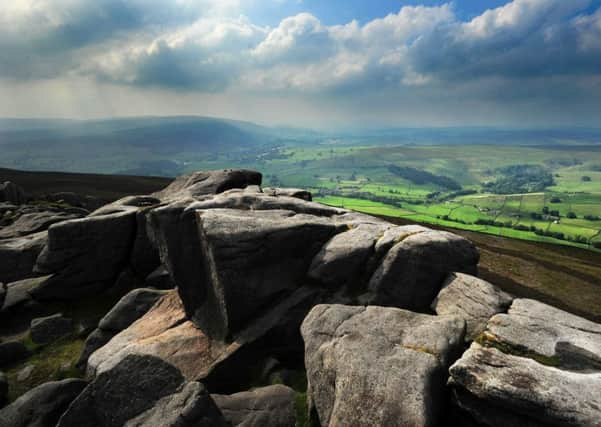Andrew Vine: It's not just about housing '“ time for a wider debate about the Dales


Worth the sweat and aching legs, though, for the views. There, in all their majesty and grandeur, lie the Dales spread out below, stretching away as far as the eye can see, yet possessed of a magical quality that makes it feel almost possible to reach out and touch the far hills.
These vistas, their colours changing with the seasons, first enchanted me as a child and their spell has only grown more potent with the passing decades. Part of it is the sense of history in this landscape, of the lives and trials it has witnessed.
Advertisement
Hide AdAdvertisement
Hide AdIt doesn’t take any great leap of imagination to conjure up a picture of earlier generations toiling up to the top, even in the distant past, when they must have looked out and wondered how to scratch an existence in a setting that can be as forbidding in winter as it is benign in summer.
That feeling of timelessness is very powerful at the summit, far above the traffic or the bustle of Ilkley to the south, or Skipton to the north.
Yet it is, in part, an illusion because the Dales have evolved and changed since the first footprints were left on the slopes of Simon’s Seat, and continue to do so.
Questions hardly less profound than those asked of themselves by pioneer farmers hang over the Dales, a landscape not caught in a timewarp or solely to be admired and loved by visitors, but a living, breathing entity in which people must still earn a living.
Advertisement
Hide AdAdvertisement
Hide AdCareful management is needed to balance the often competing demands of safeguarding this precious natural environment with the need for development to ensure that the economy of the Dales does not stagnate.
It is the trickiest of balances to strike, as demonstrated by the debate over the proposals by the Yorkshire Dales National Park Authority to hike council tax on second homes.
A progressive measure, or an unfairly punitive one? Polarising, certainly. The arguments on either side are being made passionately.
The debate over the approximately 1,500 second homes centres on ensuring the Dales have a sustainable future in every sense. The park authority argues that bringing more of the properties back into permanent occupancy would address a shortage of affordable houses in an area of outstanding natural beauty where large-scale building of new homes is out of the question.
Advertisement
Hide AdAdvertisement
Hide AdThis, though, is an issue about more than places to live, especially for the young. It is emblematic of the broader questions and challenges facing the Dales, which revolve around the need for the economy to be more vigorous if they are to thrive.
It’s not enough to be breathtakingly beautiful and awe-inspiring. Nor are the hordes of day-trippers with walking boots and packed lunches in their rucksacks enough to sustain the Dales economy, vital though the income they bring is for businesses that depend on tourism.
Dales communities need to prosper in their own right within a sensitively-managed landscape if they are to have a bright future, with successful businesses creating jobs.
That’s much easier said than done. The long-standing problem of poor broadband in rural areas holds businesses back and makes it difficult to compete on equal terms with those in urban areas.
Advertisement
Hide AdAdvertisement
Hide AdThe need for action to boost the Dales economy is ever more pressing, and has been underlined by a series of reports over the past couple of years. While none was specific to the area, the findings of each have had particular resonance there.
Public Health England and the Local Government Association warned of increasing rural deprivation in apparently idyllic towns and villages. Low-paid work, unemployment, high housing costs, fuel poverty, poor transport links and social isolation amongst the elderly were all growing problems.
Then the Centre for Towns pointed out that small towns and villages lost more than a million young people over the past three decades as they moved to the cities in search of work.
Over the same period, there was an influx of more than two million people aged 65 and over into the smaller places. The trend was particularly pronounced in the North.
Advertisement
Hide AdAdvertisement
Hide AdGovernment stinginess towards national parks is only aggravating matters, with overall funding levels potentially a fifth lower by 2020 than they were in 2010, added to which is the uncertainty of what happens post-Brexit when EU money is no longer available.
And successive governments have failed to give sufficient help to the Dales. There has been institutional neglect of the countryside by the major parties, a belief that it will somehow muddle through and sort out its own problems, whilst all the focus – and spending – is on urban areas.
All these worrying trends come together in the Dales. An ageing population, as young people move out to find work, or because they simply cannot afford a home of their own even if they would like to stay, cannot result in anything except a long, slow, downward spiral for communities.
That can’t be allowed to happen. The Dales and its people deserve better. Good could eventually come out of the acrimony over second homes because this is a watershed moment.
Advertisement
Hide AdAdvertisement
Hide AdIt’s not just about housing. This is the time to begin a wider debate about the challenges the Dales face, the help they need, and how best to create a thriving future for this glorious part of Yorkshire.